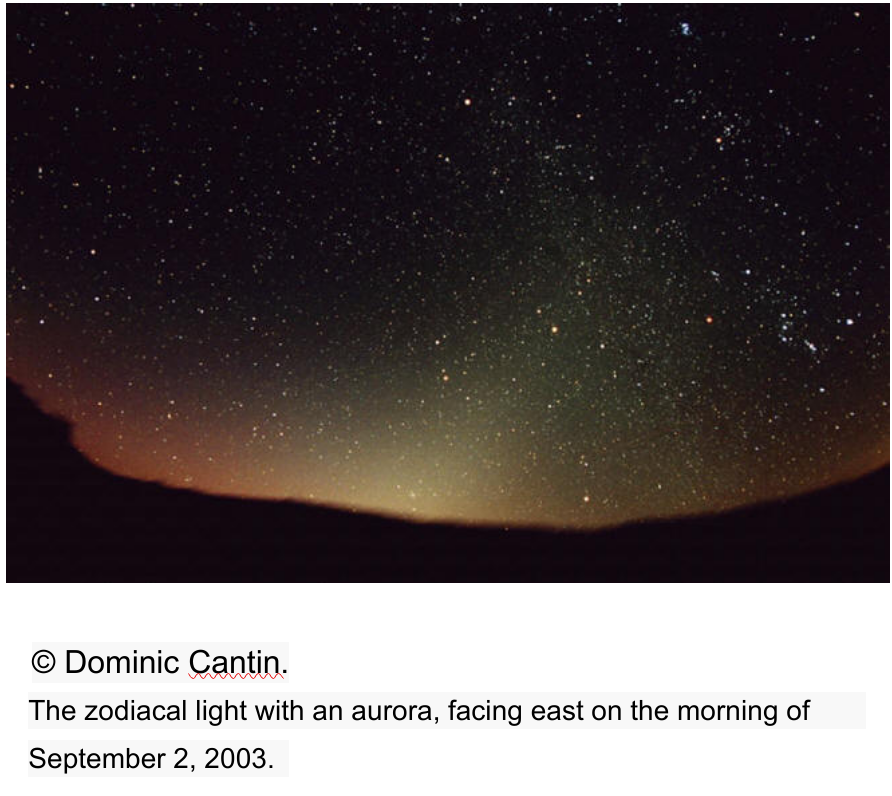[The Unwavering Truth about the Zodiacal Light 黄道光についての揺るぎない真実]

2003年9月2日の朝に東を向いたオーロラのある黄道光。
――――――――
Aug 10, 2009
あまりにも多くの場合、標準的な教科書や辞書は、特定の科学的主題について知られていることの現実的な絵を提供していません。彼らは異常な証拠を抑制する傾向があるので、確かな証明された事実の幻想は、批判的で好奇心旺盛な人々の心を落ち着かせ、科学の進歩を遅らせることができます。
黄道光はその好例です。
このあまり知られていない現象は、黄道面全体に散乱する、彗星起源の微小な塵の粒子の雲で反射する太陽光によって生成される、ほぼ三角形の光錐です。
中緯度では、光は「偽の夜明け」と間違われることがよくあります、これは、夜明け前の東、または春と秋の夕方の薄明後の西で最もよく見られるためです。
強いオーロラの10,000分の1と
–その輝きがとても弱いので
–ヨーロッパでは、黄道光が1683年にイタリアの天文学者、ジョヴァンニカッシーニ(1625-1712)によってのみ発見されたのに対し、古典的な哲学者はそれをまったく知らなかったようです。
黄道光には、反射された太陽光よりも多くのものがあるということは、そこで観察された脈動やその他の予期しない変動の目撃者の説明から生じています。
カッシーニ自身は、光の明るさの断続的な変化に気づき、わずか10回の観測の後で、黄道光の軸が黄道ではなく、太陽の赤道で上下したと結論付けました。
勇敢な探検家であり、地磁気のパイオニアであるアレクサンダー・フォン・フンボルト男爵(1769-1859)は、南アメリカを旅行中に同様の混乱を目撃しました:
「私は、南米の熱帯気候で、黄道光の強度の変化を観察することに時々驚かされました。
何ヶ月もの間、野外、川のほとり、そしてラノスで夜を過ごしたときも、私はこの現象を注意深く調べる十分な機会を楽しみました。
黄道光が最も強かったとき、私はそれが再び完全な輝きで突然輝くまで、それが数分間知覚できるほど弱くなるであろうことを観察しました。
私は私が知覚できると思った 、いくつかの例では、
–正確には赤みがかった色ではなく、下部が弧状に暗くなり、シンチレーション(火花、蛍光粒子衝突反応)さえもありません、マイランが観察したように、
–しかし、一種の光のちらつきと揺れが有りました。
星雲の様なあいまいなリングで実際に変更が進行中であると想定する必要がありますか?」
今日まで、ディザリング(凡庸)な科学者達は一様にこの問題に取り組んでいませんでしたが、多くの好奇心旺盛な学者は少なくともこの課題を認めていました。
ノルウェーで最も有名なオーロラ研究者であるクリスチャン・バークランド(ビルケランド)は、この問題に悩まされていました。
バークランドは、黄道光の振動を目撃したことを確信しており、これらを測定することに熱心であり、この現象を研究するためにスーダンへの衝動的な出発を促しました。
バークランドの疑念は、その脈動の
「光の強さと形が
…確かに電気の起源を証明しています…」
確かに、それは「オーロラの光や地磁気の振動で時々見られる脈動に似ている」に違いない筈です。
バークランドは、黄道光に大きな関心を持っていたアメリカ海軍の牧師であるジョージ・ジョーンズ(1800-1870)の証言でこの印象を強化しました。
ある時、ジョーンズは「黄道光が横方向および上方向に腫れ、光自体の明るさが増した」と報告しました;
その後、数分で境界線が縮小し、光が暗くなります;
後者は、時にはそれが完全に死にかけているように見える程度に;
そして、そのため前後に約4分の3時間ほど…」
バークランドは、黄道光のかなりの構成要素が反射された太陽光によるものであることを認めましたが、光の一部はオーロラと同じ方法で–粒子の励起により生成されるとも推論しました。
残念ながら、彼は振動を測定することができませんでしたが、彼のテレラ実験はこの仮説を支持しているように見えました。
脈動、動きの速い波、一時的な不可視性、黄道光の予期しない「視差」の肉眼観察が、時には数日のタイムスケールで行われ続けました。
1990年には、かなり活発なオーロラ表示に続いて黄道光が明るくなるのが見られました。
これにより、少なくとも1人の現代の研究者、故ニールボーン(1959-2009)が導かれました、「黄道光の拡散グロー光は…、主に内太陽系の無数の小さな粒子からの太陽光の反射によって生成されますが、オーロラ効果と何らかの関連がある。」と認めました。
明らかに、黄道光の謎はまだ解明されておらず、学ぶべきことがたくさんあります。
現代の用語では、「小体光線」または太陽の赤道面から放出される電子の流れに関するバークランドの提案された説明は、黄道光に対する太陽風の直接的な影響に変換されますか?
その場合、宇宙科学者はためらうべきではありません、やがて、ほこりがほとんど残らないので、黄道光自体は、補充されない限り、過去のものになります。
科学的な議論にほこりが落ち着くまでにはまだ長い時間がかかるかもしれませんが、今こそ、バークランドが望んでいた測定値を実行して取得するときです。
Contributed by Rens Van der Sluijs
レン・ファン・デル・スルージスによる寄稿
――――――――
Aug 10, 2009
Too often, standard textbooks and dictionaries do not offer a realistic picture of what is known about a given scientific subject. As they tend to suppress anomalous evidence, the illusion of solid proven fact is then allowed to lull the minds of the critical and the curious and slow down the progress of science.
あまりにも多くの場合、標準的な教科書や辞書は、特定の科学的主題について知られていることの現実的な絵を提供していません。彼らは異常な証拠を抑制する傾向があるので、確かな証明された事実の幻想は、批判的で好奇心旺盛な人々の心を落ち着かせ、科学の進歩を遅らせることができます。
The zodiacal light is a case in point.
黄道光はその好例です。
This little-known phenomenon is a roughly triangular cone of light, produced by sunlight reflecting off a cloud of minuscule dust particles, of cometary origin, that is scattered across the ecliptic plane.
このあまり知られていない現象は、黄道面全体に散乱する、彗星起源の微小な塵の粒子の雲で反射する太陽光によって生成される、ほぼ三角形の光錐です。
At mid-latitude, the light is often mistaken for a ‘false dawn’, as it is best seen in the east preceding the dawn or in the west following the evening twilight in respectively spring and autumn.
中緯度では、光は「偽の夜明け」と間違われることがよくあります、これは、夜明け前の東、または春と秋の夕方の薄明後の西で最もよく見られるためです。
As the glow is so faint
– 10,000 times weaker than that of a strong aurora
– it is not very surprising that, in Europe, the zodiacal light was only discovered in 1683 by the Italian astronomer, Giovanni Cassini (1625-1712), while the classical philosophers do not seem to have known it at all.
強いオーロラの10,000分の1と
–その輝きがとても弱いので
–ヨーロッパでは、黄道光が1683年にイタリアの天文学者、ジョヴァンニカッシーニ(1625-1712)によってのみ発見されたのに対し、古典的な哲学者はそれをまったく知らなかったようです。
That there is more to the zodiacal light than reflected sunlight follows from a spate of eyewitness accounts of pulsations and other unexpected fluctuations observed in it.
黄道光には、反射された太陽光よりも多くのものがあるということは、そこで観察された脈動やその他の予期しない変動の目撃者の説明から生じています。
Cassini himself had noted intermittent variations in the brightness of the light and concluded after just ten observations that the axis of the zodiacal light rose and sank not with the ecliptic, but with the equator of the sun.
カッシーニ自身は、光の明るさの断続的な変化に気づき、わずか10回の観測の後で、黄道光の軸が黄道ではなく、太陽の赤道で上下したと結論付けました。
The intrepid explorer and pioneer of geomagnetism, Alexander, baron von Humboldt (1769-1859), witnessed similar perturbations during his travels in South America:勇敢な探検家であり、地磁気のパイオニアであるアレクサンダー・フォン・フンボルト男爵(1769-1859)は、南アメリカを旅行中に同様の混乱を目撃しました:
“I have occasionally been astonished, in the tropical climates of South America, to observe the variable intensity of the zodiacal light.
「私は、南米の熱帯気候で、黄道光の強度の変化を観察することに時々驚かされました。
As I passed the nights, during many months, in the open air, on the shores of rivers and on llanos, I enjoyed ample opportunities of carefully examining this phenomenon.
何ヶ月もの間、野外、川のほとり、そしてラノスで夜を過ごしたときも、私はこの現象を注意深く調べる十分な機会を楽しみました。
When the zodiacal light had been most intense, I have observed that it would be perceptibly weakened for a few minutes, until it again suddenly shone forth in full brilliancy.
黄道光が最も強かったとき、私はそれが再び完全な輝きで突然輝くまで、それが数分間知覚できるほど弱くなるであろうことを観察しました。
In some few instances I have thought that I could perceive
– not exactly a reddish coloration, nor the lower portion darkened in an arc-like form, nor even a scintillation, as Mairan affirms he has observed
– but a kind of flickering and wavering of the light.
私は私が知覚できると思った 、いくつかの例では、
–正確には赤みがかった色ではなく、下部が弧状に暗くなり、シンチレーション(火花、蛍光粒子衝突反応)さえもありません、マイランが観察したように、–しかし、一種の光のちらつきと揺れが有りました。
Must we suppose that changes are actually in progress in the nebulous ring?”
星雲の様なあいまいなリングで実際に変更が進行中であると想定する必要がありますか?」
Until today, dithering scientists have not addressed the question in unison, but a number of inquisitive scholars did at least acknowledge the challenge.
今日まで、ディザリング(凡庸)な科学者達は一様にこの問題に取り組んでいませんでしたが、多くの好奇心旺盛な学者は少なくともこの課題を認めていました。
Kristian Birkeland, Norway's most famous auroral researcher, was gripped by the problem.
ノルウェーで最も有名なオーロラ研究者であるクリスチャン・バークランド(ビルケランド)は、この問題に悩まされていました。
Birkeland was confident he had witnessed oscillations in the zodiacal light and was eager to measure these, prompting his impulsive departure to Sudan to study the phenomenon.
バークランドは、黄道光の振動を目撃したことを確信しており、これらを測定することに熱心であり、この現象を研究するためにスーダンへの衝動的な出発を促しました。
Birkeland’s suspicion was that the pulsation in “the intensity and shape of the light
… surely testifies to an electric origin …”
Indeed, it would have to be “akin to the pulsation which is sometimes seen in auroral lights and the oscillations in terrestrial magnetism.”
バークランドの疑念は、その脈動の
「光の強さと形が
…確かに電気の起源を証明しています…」
確かに、それは「オーロラの光や地磁気の振動で時々見られる脈動に似ている」に違いない筈です。
Birkeland buttressed this impression with the testimony of George Jones (1800-1870), a chaplain of the United States Navy who had had a marked interest in the zodiacal light.
バークランドは、黄道光に大きな関心を持っていたアメリカ海軍の牧師であるジョージ・ジョーンズ(1800-1870)の証言でこの印象を強化しました。
On one occasion, Jones reported “a swelling out, laterally and upwards, of the zodiacal light, with an increase of brightness in the light itself;
ある時、ジョーンズは「黄道光が横方向および上方向に腫れ、光自体の明るさが増した」と報告しました;
then in a few minutes, a shrinking back of the boundaries, and a dimming of the light;
その後、数分で境界線が縮小し、光が暗くなります;
the latter to such a degree as to appear, at times, as if it was quite dying away;
後者は、時にはそれが完全に死にかけているように見える程度に;
and so back and forth for about three quarters of an hour …”
そして、そのため前後に約4分の3時間ほど…」
Birkeland accepted that a substantial constituent of the zodiacal light was due to reflected sunlight, yet also reasoned that some of the light is produced in the same way as the aurorae
– by an excitation of particles.
バークランドは、黄道光のかなりの構成要素が反射された太陽光によるものであることを認めましたが、光の一部はオーロラと同じ方法で–粒子の励起により生成されるとも推論しました。
Unfortunately, although his terrella experiments seemed to support this hypothesis, he was never able to measure the oscillations.
残念ながら、彼は振動を測定することができませんでしたが、彼のテレラ実験はこの仮説を支持しているように見えました。
Naked-eye observations of pulsations, fast moving waves, a temporary invisibility and unexpected ‘parallaxes’ in the zodiacal light continued to be made, sometimes on timescales of a few days.
脈動、動きの速い波、一時的な不可視性、黄道光の予期しない「視差」の肉眼観察が、時には数日のタイムスケールで行われ続けました。
In 1990, the zodiacal light was seen to brighten following a fairly vigorous auroral display.
1990年には、かなり活発なオーロラ表示に続いて黄道光が明るくなるのが見られました。
This led at least one modern researcher, the late Neil Bone (1959-2009), to admit that “the diffuse glow of the zodiacal light…, produced mainly by reflection of sunlight from myriads of small particles in the inner solar system does have some association with auroral effects.”
これにより、少なくとも1人の現代の研究者、故ニールボーン(1959-2009)が導かれました、「黄道光の拡散グロー光は…、主に内太陽系の無数の小さな粒子からの太陽光の反射によって生成されますが、オーロラ効果と何らかの関連がある。」と認めました。
Clearly, the mystery of the zodiacal light has not yet been fathomed and there is much to be learned.
明らかに、黄道光の謎はまだ解明されておらず、学ぶべきことがたくさんあります。
In modern terms, does Birkeland’s proposed explanation in terms of ‘corpuscular rays’ or streams of electrons emitted from the equatorial plane of the sun translate to a direct influence of the solar wind on the zodiacal dust?
現代の用語では、「小体光線」または太陽の赤道面から放出される電子の流れに関するバークランドの提案された説明は、黄道光に対する太陽風の直接的な影響に変換されますか?
In that case, space scientists ought not to vacillate, as, before long, so little dust will be left that the zodiacal light itself, unless replenished, will become a thing of the past.
その場合、宇宙科学者はためらうべきではありません、やがて、ほこりがほとんど残らないので、黄道光自体は、補充されない限り、過去のものになります。
Though it may still be long before the dust settles on the scientific debate, now is the time to act and obtain the measurements Birkeland had so much desired to make.
科学的な議論にほこりが落ち着くまでにはまだ長い時間がかかるかもしれませんが、今こそ、バークランドが望んでいた測定値を実行して取得するときです。
Contributed by Rens Van der Sluijs
レン・ファン・デル・スルージスによる寄稿